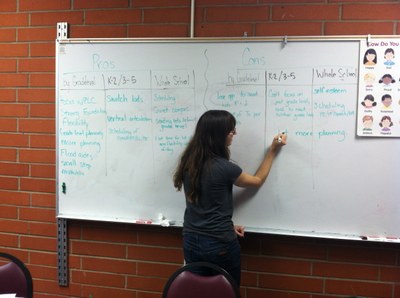Linwood E. Howe Leadership Team
 Overview of Linwood E. Howe’s Leadership Team
Overview of Linwood E. Howe’s Leadership Team
Linwood E. Howe’s Leadership Team is made up of one grade level lead kindergarten through fifth grade, a special education lead teacher, the physical education coordinator, and the school principal. We 2-3 times a month to discuss issues that come up throughout the school year.
Role as the First Grade Representative on Leadership
 Being the first grade leadership representative for the school’s leadership team, has been a big responsibility this year. With the change to the CCSS, we have had a lot more meetings this year than in previous years. We have had several half-day meetings to look at and revise the school’s schedule, calendar, programs, and community events. Leadership team has also had to have several impromptu meeting this year to discuss staff climate and bring up issues or concerns of the staff.
Being the first grade leadership representative for the school’s leadership team, has been a big responsibility this year. With the change to the CCSS, we have had a lot more meetings this year than in previous years. We have had several half-day meetings to look at and revise the school’s schedule, calendar, programs, and community events. Leadership team has also had to have several impromptu meeting this year to discuss staff climate and bring up issues or concerns of the staff.
As a member of the leadership team, I have participated in multiple day-long district professional development sessions on creating a positive and healthy school climate/culture, establishing Professional Learning Communities, and Response to Intervention. I have also worked with my fellow leadership team members to help solve school wide and grade level issues or concerns including: school wide bell schedule, morning flag salute routines, grade level assessments, implementing grade level PLCs, planning grade level intervention times and activities.
Reflection
 I learned that when teachers are in a state of transition, like the one we are currently experiencing in education with CCSS, staff climate is likely to weaken. Some teachers are afraid of change, so they start talking and stirring up others staff members. Through this experience, I learned that school leaders need to address and prepare their staff for a period of transition in order to maintain positive staff climate. Being on my school’s leadership team has shown me just how important it is to build a trustworthy, caring, and collaborative leadership team to see problems in different ways, develop multiple ways to resolve the issues, and to help keep a positive staff climate to maintain a healthy school culture.
I learned that when teachers are in a state of transition, like the one we are currently experiencing in education with CCSS, staff climate is likely to weaken. Some teachers are afraid of change, so they start talking and stirring up others staff members. Through this experience, I learned that school leaders need to address and prepare their staff for a period of transition in order to maintain positive staff climate. Being on my school’s leadership team has shown me just how important it is to build a trustworthy, caring, and collaborative leadership team to see problems in different ways, develop multiple ways to resolve the issues, and to help keep a positive staff climate to maintain a healthy school culture.
CPSEL Connection
STANDARD 1: A SCHOOL ADMINISTRATOR IS AN EDUCATIONAL LEADER WHO PROMOTES THE SUCCESS OF ALL STUDENTS BY FACILITATING THE DEVELOPMENT, ARTICULATION, IMPLEMENTATION, AND STEWARDSHIP OF A VISION OF LEARNING THAT IS SHARED AND SUPPORTED BY THE SCHOOL COMMUNITY.
1.1 Facilitate the development of a shared vision for the achievement of all students based upon data from multiple measures of student learning and relevant qualitative indicators.
1.2:Communicate the shared vision so the entire school community understands and acts on the school’s mission to become a standards-based education system.
1.3: Use the influence of diversity to improve teaching and learning.
1.4: Identify and address any barriers to accomplishing the vision.
1.5: Shape school programs, plans, and activities to ensure that they are integrated, articulated through the grades, and consistent with the vision.
1.6: Leverage and marshal sufficient resources, including technology, to implement and attain the vision for all students and all subgroups of students.
STANDARS 2: ADVOCATING, NUTURING, AND SUSTAINING A SCHOOL CULTURE AND INSTRUCTIONAL PROGRAM CONDUCIVE TO STUDENT LEARNING AND STAFF PERSONAL GROWTH.
2.1: Shape a culture in which high expectations are the norm for each student as evident in rigorous academic work.
2.2: Promote equity, fairness, and respect among all members of the school community.
2.4: Guide and support the long-term professional development of all staff consistent with the ongoing effort to improve the learning of all students relative to the content standards.
2.5: Provide opportunities for all members of the school community to develop and use skills in collaboration, distributed leadership, and shared responsibility.
2.7: Utilize multiple assessments to evaluate student learning in an ongoing process focused on improving the academic performance of each student.
STANDARD 3: ENSURING MANAGEMANT OF THE ORGANIZATION, OPERATIONS, AND RESOURCES FOR A SAFE, EFFICIENT, AND EFFECTIVE LEARNING ENVIRONMENT.
3.1: Sustain safe, efficient, clean, well-maintained, and productive school environment that nurtures student learning and supports the professional growth of teachers and support staff.
3.3: Establish school structures and processes that support student learning.
3.4: Utilize effective systems management, organizational development, and problem-solving and decision-making techniques.
3.5: Align fiscal, human, and material resources to support the learning of all subgroups of students.
3.6: Monitor and evaluate the program and staff.
3.7: Manage legal and contractual agreements and records in ways that foster a professional work environment and secure privacy and confidentiality for all students and staff.

